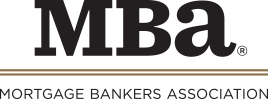
MBA: Forecast Sees Lower Volume, Higher Rates
PALM SPRINGS, CALIF.–The new year will see continuation of several trends in mortgage finance, including higher interest rates and lower mortgage origination volume, said Mortgage Bankers Association Chief Economist Mike Fratantoni.
Speaking here at the MBA Independent Mortgage Bankers Conference, Fratantoni said MBA fully expects the Federal Open Market Committee to raise the federal funds rate at least three times this year.
“We have certainly seen a sharp pickup in key interest rates,” Fratantoni said. “You have a number of Federal Reserve officials speaking in a hawkish way, given that we are near full employment and see strong consumer spending.”
For January, MBA slightly revised its 2017 forecast, to $1.5 trillion in mortgage applications as the refinance market continues to wane and the purchase market gears up further.
Interest rates, Fratantoni noted, have taken everyone by surprise. MBA had forecast a modest uptick in key interest rates above 4 percent, something that ended up happening by the end of 2016. MBA expects the 30 year mortgage rate will hit 4.7 percent by the end of 2017, reach 5 percent by the second half of 2018 and increase further to 5.5 percent by the end of 2019.
“With a large segment of borrowers having taken advantage of sub-4 percent rates in recent years, refinance volume will decrease even though rates in the 5 percent range are still very low by historical standards,” Fratantoni said.
Housing demand over the next decade continues to be a bright spot, with 1.6 million new households created per year. “This looks extremely strong,” Fratantoni said. “We don’t know how much of this will be rental and how much of this will be home purchases, but we expect you will be very busy over the next several years.”
Just as importantly, Fratantoni said, home prices have recovered to their 2006-2007 peaks, which should bode better for the existing home sales market. “The existing market is expected to do better; so is the first-time home buyer market as credit begins to loosen,” he said.
One thing MBA has been watching for, as the market shifts to a purchase market, is an increase in adjustable-rate mortgages. “We are seeing an increase, but it’s not going to reach the level that it did in the 2000s, when the ARM rate exceeded 35 percent,” Fratantoni said.
And as refinance activity shrinks, with most people who could refinance already doing so, MBA sees a gradual increase in the amount of cash-out refis as home equity increases.
Lending demographics continue to change, Fratantoni said, with independent mortgage banker share increasing (46 percent) at the expense of larger banks (assets of $10 billion or more). Community bank share (14 percent) has been relatively stable, but the number of community banks making mortgage loans have dropped substantially. “We’re seeing a lot of community banks saying that it’s too complicated and there are too many regulations to make mortgage loans.
IMB net production income has correspondingly changed as well. Back in 2008, profitability averaged 50-60 basis points. That dropped when the Dodd-Frank Act went into effect; now the profitability range rose to 70-75 basis points.
“Margins on originations have dropped about 50 basis points,” Fratantoni said. “A lot of this is involved in the cost to originate a loan.” He added that cost of servicing has also increased, resulting in lower profits. But there is a good side to this, he noted. “If you have high lending standards, you’re making better quality loans,” he said.
IMBs are also taking advantage of technology to increase efficiencies, Fratantoni said. And technology expenditures have been increasing, to nearly 8 percent of total company costs (compared to 15 percent for larger banks).
“We are seeing more and more lender interest in eMortgages,” Fratantoni said. “The interest is not universal, however. There is still a lack of knowledge on the subject, and lenders want to follow the lowest common denominator-they don’t know where a loan might end up and when first working with a borrower, so they often use paper to ensure that someone can take the loan.”
“There are two issues to focus on: how do I improve the borrower experience; and how do I lower my costs,” Fratantoni said. MBA, through its MISMO subsidiary, is trying to steer the industry toward more technology, he said. For example, MBA recently persuaded the Internal Revenue Service to accept eSignatures.
